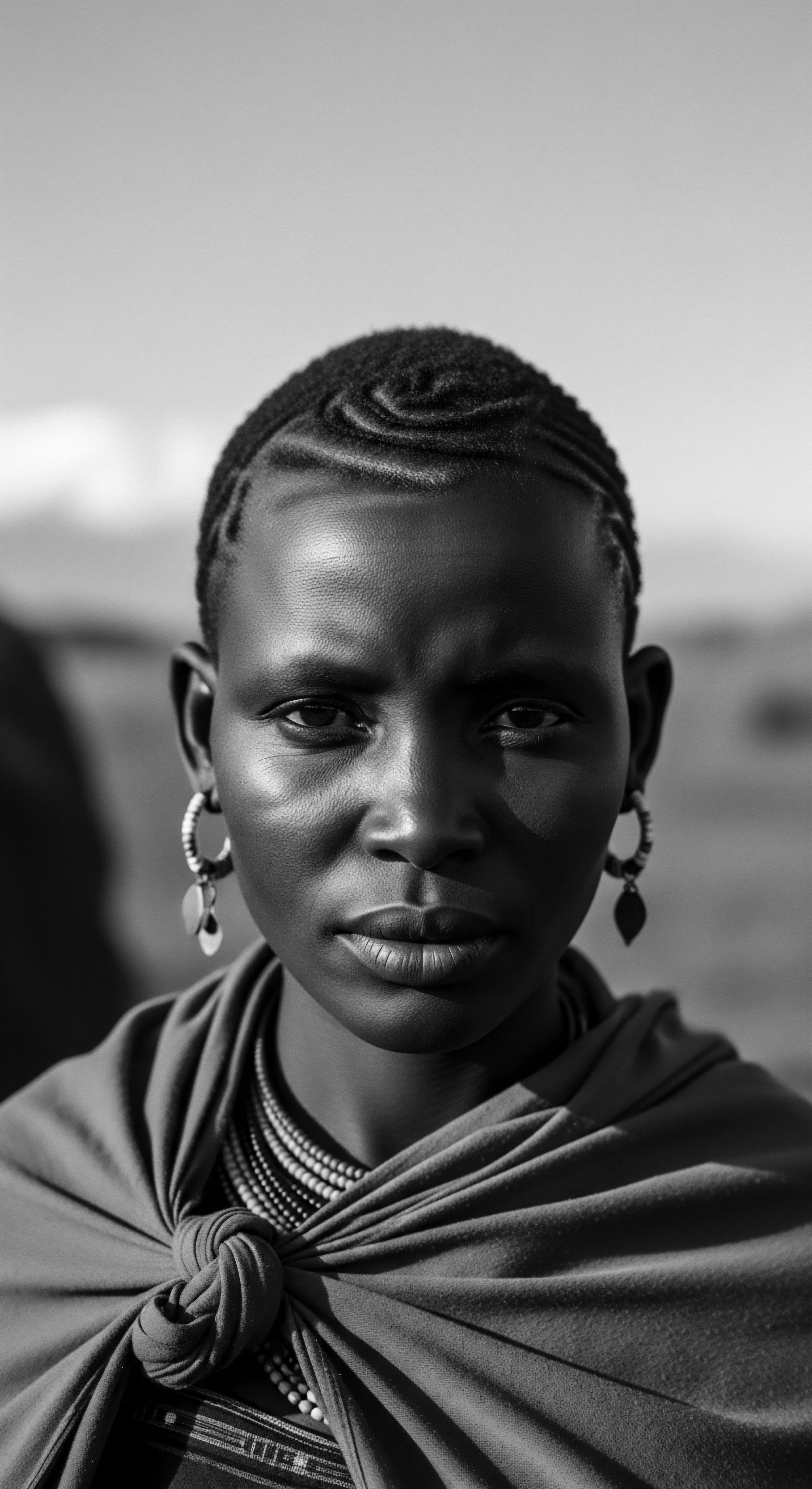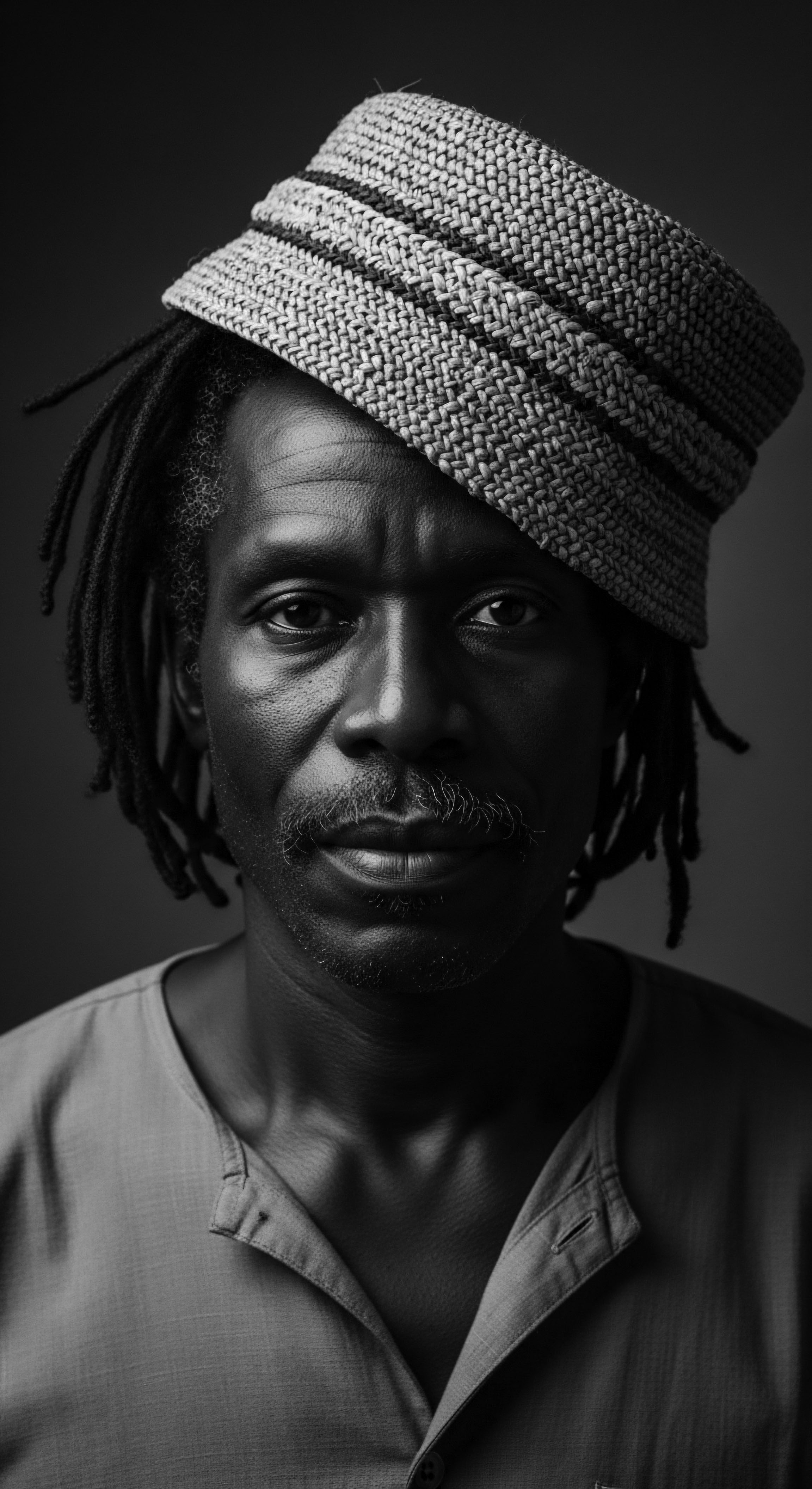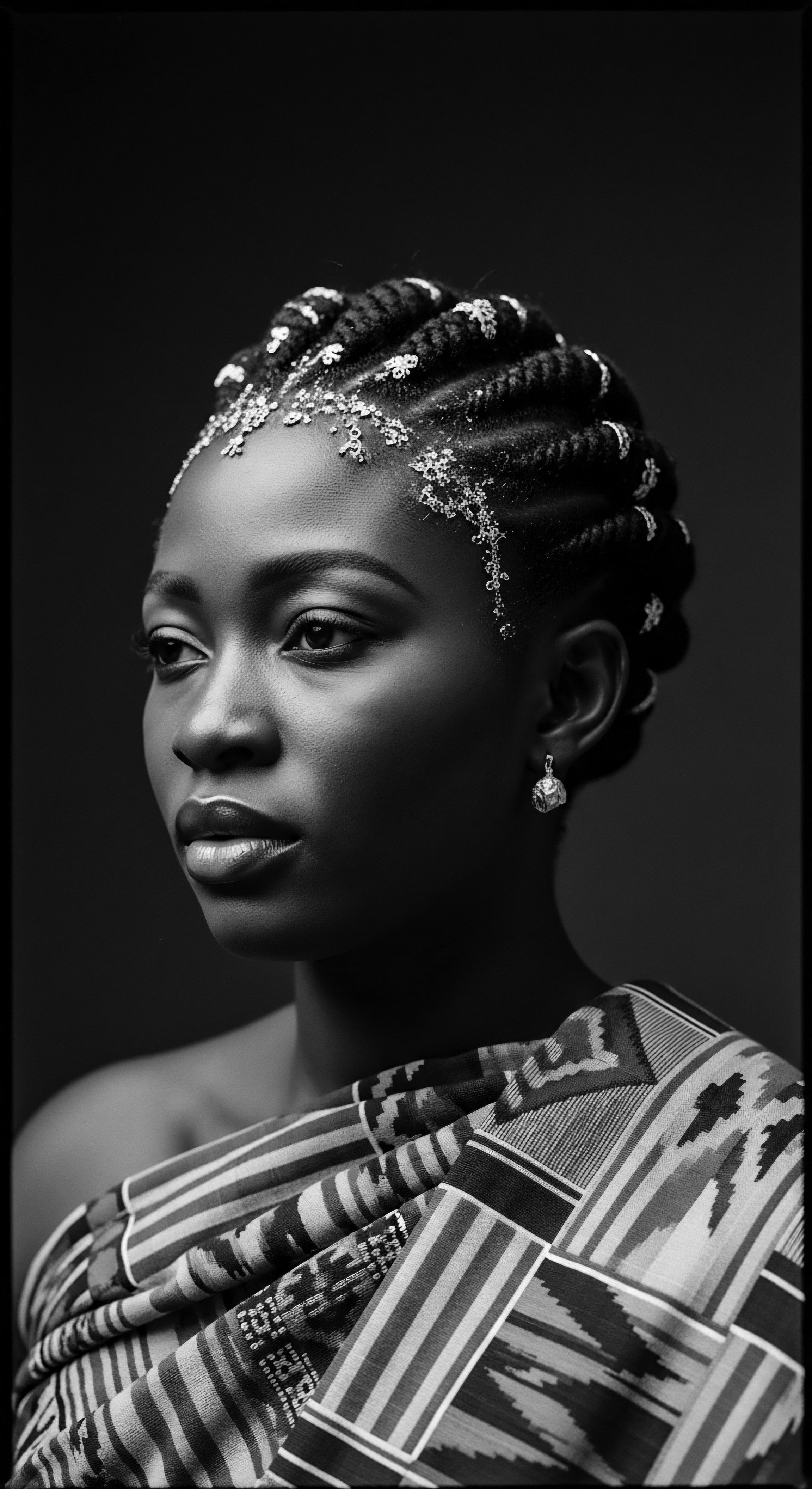
Fundamentals
The African Coralwood, known scientifically as Pterocarpus Soyauxii, represents far more than a mere botanical specimen; it is a profound testament to ancestral wisdom and a cornerstone of textured hair heritage across Central and West Africa. This magnificent tree, often called African Padauk or Redwood, thrives in the humid, warm embrace of its native forests, reaching considerable heights, sometimes between 20 to 30 meters. Its heartwood, a vibrant reddish-orange when freshly cut, gradually deepens to a rich purple-brown, a transformation that mirrors the enduring legacy it holds for generations.
At its core, the African Coralwood’s Definition extends beyond its biological classification within the Fabaceae family; it embodies a living archive of traditional practices. The tree’s bark, leaves, and roots have been utilized for their medicinal properties, while its wood is highly valued for crafting, furniture, and musical instruments due to its remarkable durability and resistance to water. For communities deeply connected to the land, this tree has served as a reliable source for various necessities, its utility spanning from practical applications to the deeply symbolic.

A Botanical Overview
Pterocarpus soyauxii is distinguished by its flaky bark and a dense, leafy canopy providing ample shade. Its compound leaves typically consist of 11 to 19 oblong leaflets. The tree produces yellowish flowers in panicles, which later give way to woody, orbicular pods containing seeds dispersed by natural elements. This botanical description merely scratches the surface of its true value, for its most significant attribute, particularly for our exploration, lies in its heartwood.
The African Coralwood is a living repository of ancestral knowledge, its very essence intertwined with the enduring practices of hair care and cultural identity.

Initial Encounters ❉ Traditional Uses
In its simplest sense, the African Coralwood finds its initial Meaning in the hands of those who first recognized its potential. For centuries, its reddish wood powder, often mixed with oils, has been applied as a cosmetic pomade, notably known as ‘ngula’ in the Democratic Republic of Congo. This practice highlights an early understanding of its properties, extending beyond mere adornment to a deeper engagement with the body and its care. The wood’s ability to impart a red dye, akin to other redwoods like sandalwood and narrawood, positioned it as a valuable resource for coloring fabrics and, crucially, for personal beautification.
- Cosmetic Pomade ❉ The powdered wood, often combined with palm oil or other vegetable butters, creates a reddish pomade for skin and hair.
- Natural Dye ❉ The heartwood and roots yield a red dye used for textiles and ceremonial body art.
- Traditional Tools ❉ Its durable wood is shaped into traditional hair combs, an everyday implement carrying significant cultural weight.

Intermediate
Moving beyond a basic recognition, the African Coralwood’s Explanation within Roothea’s living library begins to unfold its deeper cultural and historical significance, particularly concerning textured hair heritage. This tree, indigenous to Central and West Africa, is not simply a source of material; it is a vibrant thread in the intricate cultural fabric of diverse communities. Its presence in traditional hair practices speaks to a profound ancestral wisdom, a knowing that understood the properties of the natural world for holistic well-being long before modern science articulated such connections.

Echoes from the Source ❉ Ancestral Hair Practices
The use of African Coralwood in hair care rituals is deeply embedded in the historical narrative of African beauty traditions. Its red pigment, derived from the heartwood, has been utilized as a natural hair colorant, a practice that aligns with the broader tradition of using plant-based dyes like henna across Africa and the Middle East. This application transcends mere aesthetics; it speaks to a heritage where hair was, and remains, a powerful symbol of identity, status, and spiritual connection.
In Cameroon, for instance, the bark of Pterocarpus Soyauxii is macerated or crushed and applied to the scalp as a hair colorant. This method reflects a sophisticated understanding of plant extraction and topical application, passed down through generations.
The enduring presence of African Coralwood in ancestral hair rituals underscores a timeless connection between the earth’s bounty and the deeply personal act of hair care.
Beyond coloring, the wood’s resilience made it an ideal material for crafting tools essential to hair maintenance. Traditional hair combs carved from African Coralwood are not merely functional items; they are artifacts imbued with the spirit of craftsmanship and the heritage of hair styling. These combs, alongside other adornments made from natural materials, underscore the ingenuity of ancestral practices in nurturing and expressing textured hair.

The Tender Thread ❉ African Coralwood in Community Care
The application of African Coralwood in hair care was often a communal activity, a social ritual that strengthened bonds and facilitated the intergenerational transfer of knowledge. In many African societies, hair care was a shared experience, an opportunity for storytelling, advice-sharing, and community building. The preparation of pomades from the powdered wood, mixed with indigenous oils, would have been a hands-on process, rich with shared laughter and quiet instruction. This collective engagement ensured the continuity of these practices, solidifying the African Coralwood’s Significance not just as an ingredient, but as a facilitator of cultural continuity.
Consider the broader context of African hair care, where hair itself holds heightened spiritual qualities and is seen as housing a person’s spirit. The careful grooming and adornment of hair, often involving intricate styles like braids, twists, and dreadlocks, served to symbolize a person’s tribe, social status, and family background. Within this framework, African Coralwood’s role in coloring or conditioning hair contributed to these deeply meaningful expressions of self and community.
| Aspect Preparation Method |
| Traditional Approach (Ancestral Wisdom) Powdered heartwood macerated or crushed, mixed with local oils (e.g. palm oil) to form a pomade. |
| Contemporary Relevance (Modern Application) Extracts integrated into formulated conditioners, hair masks, or natural dyes, often with scientific validation. |
| Aspect Primary Application |
| Traditional Approach (Ancestral Wisdom) Hair colorant, scalp treatment, cosmetic pomade for body and hair. |
| Contemporary Relevance (Modern Application) Natural hair dye alternative, antioxidant scalp treatment, ingredient in restorative hair products. |
| Aspect Cultural Context |
| Traditional Approach (Ancestral Wisdom) Deeply communal rituals, intergenerational knowledge transfer, expression of identity and status. |
| Contemporary Relevance (Modern Application) Individualized self-care, connection to heritage, ethical sourcing considerations, natural hair movement. |
| Aspect The enduring utility of African Coralwood bridges historical practices with modern desires for natural, heritage-aligned hair care. |

Academic
The African Coralwood, Pterocarpus Soyauxii, commands a multifaceted academic Definition that extends beyond its botanical classification to encompass its profound ethnobotanical, phytochemical, and cultural anthropological implications, particularly within the context of textured hair heritage. This deep exploration necessitates a rigorous examination of its biological compounds, historical trajectories of use, and the intricate social structures it has historically supported. The very designation of this tree, often referred to as African Padauk or Redwood, hints at its rich red heartwood, a property that has been instrumental in its traditional applications.

Phytochemical Profile and Bioactivity ❉ Unpacking the Source
From a scientific vantage point, the African Coralwood’s Composition reveals a complex array of compounds that contribute to its historical efficacy. The heartwood of Pterocarpus soyauxii contains notable biflavonoids such as Santalin A, Santarubin A, and Santarubin B, alongside isoflavonoids like Pterocarpin, Formononetin, and Prunetin. These compounds, particularly the flavonoids and phenolic constituents, have been linked to antioxidant and anti-inflammatory properties. Such a biochemical profile provides a compelling scientific basis for its traditional use in various skin and scalp applications, including those related to hair care.
A study investigating the antioxidant and antibacterial activities of various plant extracts used in Congolese cosmetopoeia highlighted the red wood of Pterocarpus Soyauxii, known locally as ‘Ngola,’ for its use in skin and hair care. While further in-vivo studies are recommended to fully elucidate its benefits, the presence of these active compounds suggests a scientific validation for the long-held ancestral wisdom regarding its restorative and protective qualities for the scalp and hair. This alignment between traditional knowledge and modern scientific inquiry underscores the profound understanding that indigenous communities possessed regarding their natural environment.

Ancestral Practices and Hair as a Cultural Text
The Interpretation of African Coralwood’s role in textured hair heritage requires an anthropological lens, viewing hair not merely as a biological appendage but as a potent medium for cultural expression, social status, and spiritual connection. In pre-colonial African societies, hairstyles served as intricate communication systems, conveying messages about an individual’s tribe, age, marital status, and social standing. The unique texture of African hair, with its remarkable ability to be shaped and sculpted, facilitated these elaborate designs, making it a powerful canvas for identity.
Within this context, the application of African Coralwood as a hair colorant or as a component in conditioning pomades gains deeper Connotation. It was not simply about changing hair color; it was about participating in a communal ritual, affirming one’s place within the collective, and honoring ancestral aesthetics. For instance, the use of a red dye, potentially derived from Pterocarpus soyauxii, to color raffia fiber ornaments worn by Bulu women in Cameroon, or the incorporation of its red dyes into the famous ‘Kasai velvets’ of the Kuba kingdom in DR Congo, illustrates how the plant’s aesthetic properties were interwoven with cultural markers of identity and artistic expression. This historical example provides a tangible link between the plant and its symbolic function within cultural adornment, extending to hair as a significant aspect of personal presentation.
The red hues imparted by African Coralwood carried a visual language, speaking volumes about identity, status, and spiritual connection within diverse African communities.
The traditional use of Pterocarpus Soyauxii in crafting hair combs further solidifies its integral role in textured hair heritage. These combs, often meticulously carved, were not merely utilitarian objects; they were extensions of the hand, instruments of care that facilitated the intricate styling practices essential to communal life. The act of combing, detangling, and styling hair was often a shared experience, particularly among women, fostering social bonds and transmitting cultural knowledge from one generation to the next. This underscores the idea that hair care, facilitated by materials like African Coralwood, was a collective endeavor, reinforcing community ties and preserving cultural legacies.

The Unbound Helix ❉ African Coralwood in a Modern Context
The contemporary resurgence of interest in natural hair care, particularly within Black and mixed-race communities, has brought renewed attention to traditional African ingredients. African Coralwood, with its historical precedent and scientifically recognized properties, stands as a compelling candidate for modern applications that honor ancestral wisdom. The growing natural hair movement, which celebrates coils and kinks, seeks chemical-free, organic solutions, often turning to ancient remedies. This shift creates a fertile ground for the reintegration of materials like African Coralwood, not as exotic novelties, but as respected elements of a living heritage.
The conservation status of Pterocarpus Soyauxii, listed as vulnerable due to over-exploitation and habitat loss, adds another layer of complexity and urgency to its academic discourse. Understanding its ecological role and promoting sustainable harvesting practices becomes paramount if its cultural and medicinal legacy is to endure. This contemporary challenge necessitates a balanced approach, integrating ethnobotanical knowledge with ecological conservation efforts, ensuring that future generations can continue to benefit from and connect with this remarkable tree.
The Delineation of African Coralwood within Roothea’s ‘living library’ is therefore not static; it is a dynamic process of discovery and rediscovery. It invites us to consider how ancient practices, grounded in deep ecological understanding, can inform and enrich modern approaches to textured hair care, fostering a connection to heritage that transcends time.
- Ethnobotanical Documentation ❉ Research highlights the historical and ongoing use of Pterocarpus Soyauxii bark as a hair colorant in Cameroon.
- Cosmetic Applications ❉ The wood powder mixed with oil has been widely used as a body cosmetic and pomade in DR Congo.
- Tool Crafting ❉ Durable wood of African Coralwood is favored for traditional hair combs and musical instruments.

Reflection on the Heritage of African Coralwood
As we conclude this exploration of the African Coralwood, Pterocarpus Soyauxii, it becomes clear that its true Meaning extends far beyond its botanical classification or chemical composition. This magnificent tree stands as a resonant symbol within Roothea’s ‘living library,’ embodying the profound connection between the earth’s gifts and the enduring spirit of textured hair heritage. It whispers stories of ancestral hands that knew its power, of communities that gathered under its shade, and of traditions that celebrated hair as a sacred extension of self and lineage. The journey from elemental biology to its role in shaping identity is not a linear one; rather, it is a cyclical dance, an unbroken continuum where the wisdom of the past informs the possibilities of the future.
The African Coralwood, with its vibrant heartwood and resilient nature, serves as a poignant reminder that the care of textured hair has always been, at its very core, an act of remembrance and reverence. It is a tangible link to a heritage that understood beauty not as a superficial adornment, but as an expression of holistic well-being, deeply rooted in cultural context and ancestral practices. The very act of incorporating such ingredients into our modern routines becomes a silent conversation with those who came before us, a reaffirmation of the strength and beauty that resides within our coils and kinks.
This plant’s story, woven through the narratives of Central and West African communities, underscores the profound wisdom held within indigenous knowledge systems. It challenges us to look beyond the immediate, to appreciate the centuries of observation, experimentation, and cultural integration that have shaped our understanding of natural ingredients. The African Coralwood is not just a definition; it is an invitation to lean into the richness of our hair’s ancestral story, to honor the tender thread of care that has been passed down, and to recognize the unbound helix of identity that continues to evolve, rooted firmly in the echoes from the source.
The African Coralwood stands as a vibrant testament to the deep, unbroken lineage of care and cultural expression embedded within textured hair heritage.

References
- Adjanohoun, E. J. & Ake Assi, L. (1993). Contribution to Ethnobotanical and Floristic Studies in Togo. Agence de Coopération Culturelle et Technique.
- Burkill, H. M. (1995). The Useful Plants of West Tropical Africa, Vol. 3 ❉ Families J–L. Royal Botanic Gardens, Kew.
- Dalziel, J. M. (1937). The Useful Plants of West Tropical Africa. Crown Agents for Overseas Governments and Administrations.
- Govaerts, R. (2001). World Checklist of Seed Plants, Vol. 3(1, 2a & 2b). MIM, Deurne.
- Nascimento, M. M. et al. (2020). Cosmetopoeia of African Plants in Hair Treatment and Care ❉ Topical Nutrition and the Antidiabetic Connection? Cosmetics, 7(4), 85.
- Orwa, C. Mutua, A. Kindt, R. Jamnadass, R. & Simons, A. (2009). Agroforestree Database ❉ a tree reference and selection guide version 4.0. World Agroforestry Centre.
- PROTA (Plant Resources of Tropical Africa) (2008). Pterocarpus soyauxii. PROTA4U.
- Sallé, G. et al. (2007). Tropical Woody Plants. Quae.
- Tarlo, E. (2019). Racial hair ❉ the persistence and resistance of a category. Journal of the Royal Anthropological Institute, 25(2), 324-348.
- Walker, A. (1990). The Temple of My Familiar. Harcourt Brace Jovanovich.
